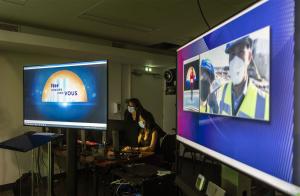Open Doors Day goes virtual
For 15 years ITER has been opening its doors to visitors, either in small groups or during regular Open Doors Days. Approximately 160,000 visitors from all horizons—school children, students, members of the public, companies, politicians—have passed through the ITER gates since 2007, returning home with a better idea of the scale and importance of ITER and of the passion that inhabits the men and women who work here.
Benoit Manfreo, a technical officer for tokamak integration, has been involved in ITER Open Doors Days for many years. "I've always enjoyed interacting with the visitors. For us, engineers and technical officers, it is important to connect with the general public, to answer questions, to feed curiosity, and to keep track of the broader picture—the purpose of ITER, why we are doing it, and what this unique technological adventure stands for ..."
Traditionally organized twice a year in spring and autumn, the event usually attracts 1,000 visitors, hosted by up to 50 volunteers from the ITER Organization, its partners Fusion for Energy (the European Domestic Agency) and Agence Iter France, and on-site actors APAVE (health and safety) and ENGAGE (architect engineering).
For the first edition in October 2011, there was not much to show on the platform: a "near-finished" Poloidal Field Coils Winding Facility, a "forest of pylons" in the electrical switchyard, and a 17-metre-deep excavation where installation work had just begun on the anti-seismic system of the Tokamak Complex.
Over time the ITER landscape changed dramatically, with an ever increasing number of buildings, technical areas and storage facilities. Today, 10 years after the first edition, construction works have passed the 80 percent mark, giant components are arriving, and assembly activities are underway.
Most recently, these dramatic changes were taking place against the backdrop of the global pandemic. Like every other organization, ITER's outreach efforts were severely impacted by the COVID-19 crisis, so this autumn the team decided on a virtual format for its Open Doors Day. The event organized on 27 October in French and in English combined different types of on-line content such as recorded or live presentations, videos, a virtual reality demonstration, and more.
"For the two past editions, I had adapted the 3D tools that ITER designers use on a daily basis for the general public in a way that offered them the chance to navigate inside the machine," says Manfreo, who is in charge of ITER's virtual reality room. "For the remote edition, we decided to pre-record a 15-minute demonstration so that visitors could still have the chance to participate in this unique immersive experience. As we are now in the machine assembly phase, this is the perfect tool for understanding ongoing operations!"
The traditional "plasmagician" was also on stage, live streamed from the ITER amphitheatre.
Other highlights were the live streams from the worksite, where technical officers and ''ITER reporters'' presented updates on some of the buildings that are traditionally part of the Open Doors Day tour; a virtual exhibition centre; and a special area where the youngest participants could download age-appropriate content such as do-it-yourself experiments, mangas, and motion design videos.
Close to 700 people from all over the globe took part in the event, including from non-ITER Member countries such as Argentina, Australia, Brazil, Indonesia, Mexico and South Africa.
Jean-Louis Bersier, a vacuum engineer at ITER, is amazed at the continued enthusiasm for Open Door Day events. "The excitement and energy from the public never fades. This year the format of the event was different, but we chose to maintain the spirit of past events, including the very popular demonstrations for children. It was challenging to do this live from the amphitheatre, but at the same time a lot of fun. Of course I am very much looking forward to the next 'real' Open Doors Day, as there is no better reward than the enthusiasm that you see in the eyes of your public."


